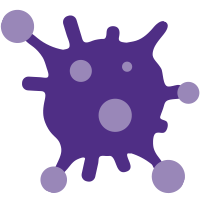
Immunology of Infectious Disease News
Immunology of Infectious Disease News is an online resource dedicated to covering the latest research and developments in the field of infectious diseases.
Designing a Multi-Epitope Universal Vaccine for Concurrent Infections of SARS-CoV-2 and Influenza Viruses Using an Immunoinformatics Approach
[BMC Infectious Diseases] Given the lack of a specific vaccine to address SARS‑CoV‑2 and influenza co-infections, investigators designed a universal vaccine using immunoinformatics methodologies.
EZH2 Inhibition Mitigates HIV Immune Evasion, Reduces Reservoir Formation, and Promotes Skewing of CD8+ T Cells toward Less-Exhausted Phenotypes
[Cell Reports] Researchers revealed enhancer of zeste homolog 2 (EZH2) overexpression as a mechanism of cytotoxic T lymphocyte resistance and support the clinical evaluation of tazemetostat as a method of enhancing clearance of HIV reservoirs and improving CD8+ T cell function.
Characterization of Serotype-Specific Dengue Virus T Cell Inhibition
[Journal of Infectious Diseases] Investigators found that Dengue virus 1 (DENV-1) and -4 viral particles and env proteins blunt T cell responses by interfering with proximal TCR signaling, while DENV-2 and -3 do not, potentially explaining DENV pathogenic outcomes in primary and secondary infection.
Strong Immune Response and Protection against Brucella abortus by Omp25 and BP26 mRNA Vaccine Candidates
[International Immunopharmacology] Researchers focused on the outer membrane proteins Omp25 and BP26 of Brucella as targets, employing a multidimensional strategy to develop novel mRNA vaccines and systematically evaluate their immunoprotective efficacy.
Intranasal Vaccination with Multi-Neuraminidase and M2e Virus-Like Particle Vaccine Results in Greater Mucosal Immunity and Protection against Influenza Than Intramuscular Injection
[Vaccine] Scientists reported that multi-subtype neuraminidase and M2 ectodomain repeatvirus-like particle vaccine conferred higher efficacy of broad cross-protection after two doses of intranasal delivery than intramuscular injection.
Impact of Staphylococcus aureus Colonization and Skin Abscesses on Formation of Human anti-αGal Antibodies
[Medical Microbiology and Immunology] Investigators studied the impact of Staphylococcus aureus colonization and abscess events on plasma anti-αGal antibody levels.
Advances in Host-Directed Therapy for Tuberculosis and HIV Coinfection: Enhancing Immune Responses
[Trends In Microbiology] Scientists explore key host-directed therapys, including cytokine therapy, CAR-T cell therapy and immune checkpoint inhibitors, which target Mycobacterium tuberculosis-infected cells, enhance immune responses, and mitigate inflammation.
Molecular Mechanisms of Viral Oncogenesis in Haematological Malignancies: Perspectives from Metabolic Reprogramming, Epigenetic Regulation, and Immune Microenvironment Remodeling
[Experimental Hematology & Oncology] The authors delve into the contributions of various known viruses—specifically Epstein-Barr virus, HIV, human T cell leukemia virus type 1, Kaposi’s sarcoma-associated herpesvirus, human cytomegalovirus, hepatitis B virus, hepatitis C virus, and human papillomavirus—in the development of haematological malignancies.
Invivyd Announces New Pipeline Discovery Program Focused on Monoclonal Antibody Treatment for Measles
[Invivyyd, Inc.] Invivyd, Inc. announced it has initiated a discovery program for a measles monoclonal antibody.
MicroRNA Changes with Macro Potential Contribute to Secondary Immunodeficiency in Chronic Lymphocytic Leukemia during Epstein Barr Virus Reactivation
[Scientific Reports] Researchers examined the interplay between miRNA expression profiles, Epstein-Barr virus reactivation, and immune checkpoint pathways in the context of small intestine disease development in chronic lymphocytic leukemia.
Epitope-Optimized Vaccine Elicits Enduring Immunity against Swine Influenza A Virus
[Nature Communications] Investigators described the Epigraph, a computationally derived and epitope optimized set of vaccine immunogens.
Porphyromonas gingivali Induces Zbp1-Mediated Macrophages PANoptosis in Periodonitis Pathophysiology
[Experimental & Molecular Medicine] Researchers found that P. gingivalis infection notably activates multiple death pathways in bone-marrow-derived macrophages, including pyroptosis, apoptosis, and necrosis.
Immunology of Infectious Disease News was founded to keep the scientific community current with the latest developments in infectious disease research. We feature high-impact publications, news, jobs, and events focused on immune responses to and the development of treatments for infectious diseases such as COVID-19, HIV, hepatitis, tuberculosis, influenza, and malaria.

 Cancer Stem Cell News
Cancer Stem Cell News Cell Therapy News
Cell Therapy News Dermal Cell News
Dermal Cell News Endothelial Cell News
Endothelial Cell News ESC & iPSC News
ESC & iPSC News Extracellular Matrix News
Extracellular Matrix News Hematopoiesis News
Hematopoiesis News Hepatic Cell News
Hepatic Cell News Human Immunology News
Human Immunology News Immune Regulation News
Immune Regulation News
 Intestinal Cell News
Intestinal Cell News Mammary Cell News
Mammary Cell News Mesenchymal Cell News
Mesenchymal Cell News Muscle Cell News
Muscle Cell News Neural Cell News
Neural Cell News Organoid News
Organoid News Pancreatic Cell News
Pancreatic Cell News Prostate Cell News
Prostate Cell News Pulmonary Cell News
Pulmonary Cell News
